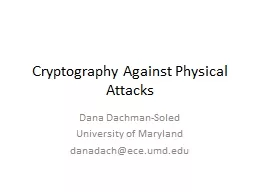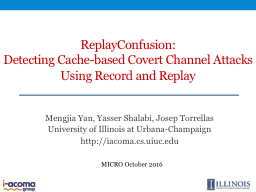PPT-Side channel attacks
Author : pasty-toler | Published Date : 2016-10-15
Computer Security 2014 Background An algorithm or software can be designed to be provably secure Eg cryptosystems small OS kernels TPM modules Involves proving
Presentation Embed Code
Download Presentation
Download Presentation The PPT/PDF document "Side channel attacks" is the property of its rightful owner. Permission is granted to download and print the materials on this website for personal, non-commercial use only, and to display it on your personal computer provided you do not modify the materials and that you retain all copyright notices contained in the materials. By downloading content from our website, you accept the terms of this agreement.
Side channel attacks: Transcript
Download Rules Of Document
"Side channel attacks"The content belongs to its owner. You may download and print it for personal use, without modification, and keep all copyright notices. By downloading, you agree to these terms.
Related Documents














